The variety of rose types and sorts is huge - all they have in common is their beauty. We introduce you to the most beautiful and popular rose classes.

Roses (pink) are a classic in the home garden. Perhaps you have already thought about getting your own, but couldn't make up your mind due to the huge selection of varieties. After all, the chosen one should not only match the personal taste of the flower color and shape, but also cope with the conditions in the garden. In rougher areas, for example, you should attach great importance to the weather tolerance, winter hardiness and robustness of the plant. Depending on the intended use, the growth habit and the flowering behavior are also important decision-making criteria.
contents
- Floribunda roses
- Shrub and bush roses
- Climbing roses
- Dwarf roses
- Hybrid Tea Roses
- Wild roses
- Historic roses
- Ground cover roses
- Tree roses
- Scented roses
- English roses
- ADR roses
The many different varieties are assigned to individual rose classes, which in turn can be grouped together. However, this can lead to overlaps. To give you an overview of the variety of roses, we would like to briefly explain the differences between the individual rose classes and groups. In addition, we will introduce you to some of the most beautiful varieties for each category in a fast run-through.
Floribunda roses
Many different varieties are summarized under the term "bed roses". In addition to the large-flowered hybrid tea roses, these include the tufted floribunda and polyantha roses. The bed roses are kept low by a regular cut and can be planted in groups or over a large area in the garden.
We find the following types of floribunda particularly beautiful:
-
'Bonica' 82 '
Robust variety with light pink flowers from June to September; can develop rose hips; lush growth; grows up to 80 cm high; rainproof and frost hardy -
‘Greetings to Aachen’
First Floribunda Pink; double, creamy white flowers; yellowish pink in the middle; delicate fragrance; bushy growth (height up to 90 cm); hardy -
‘Friesia’
Medium-sized, golden yellow flowers; pleasant smell; long and profuse flowering; upright growth; many branches; becomes about 60 cm high; good weather resistance -
'Sirius'
Half-double flowers in apricot to creamy white; blooming size; bushy, upright growth; very good leaf health; was awarded the ADR rose in 2013; hardy -
‘La Sevillana’
Semi-double flowers of bright red color; delicate fragrance; forms orange-colored rose hips; grows up to 80 cm high; good leaf health; heat tolerant
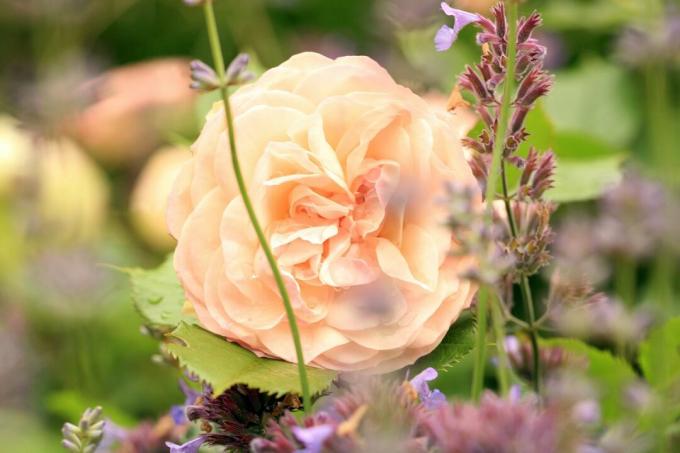
A comprehensive article with Bouquet rose varieties You will find here.
Shrub and bush roses
When you think of roses, you often see a bush in bloom. According to the growth form, these are so-called shrub roses. They can be used in many ways in the garden and are also particularly easy to care for. While small shrub roses (ground cover roses) only reach a height of 100 centimeters, large shrub roses can reach heights of up to 250 centimeters. Therefore, many varieties can also be used wonderfully for hedges or as background plants.
Here is a selection of small shrub / bush rose varieties (height from 100 to 150 cm):
-
‘Angela’
Small, half-double flowers in dusky pink; more often blooming; grows compact; reaches heights of growth of about 80 to 120 cm; good leaf health; hardy; suitable for planting in pots -
‘Belvedere’
Double apricot-orange flowers; more often blooming; bitter scent; reaches heights of about 120 to 150 cm; medium leaf health; Flowers have a long shelf life -
‘Peace Light’
Very double, creamy white flowers; more often blooming; light fragrance; upright, slightly arched growth; becomes about 120 to 150 cm high; pretty tough; rainproof flowers; frost hardy -
'Hercules'
Dense, lavender-colored flowers; more often blooming; smells of pear; upright, bushy growth with overhanging shoots (about 100 to 140 cm high); robust; hardy -
‘Rhapsody in Blue’
Semi-double, purple-violet flowers with a white center; more often blooming; light fragrance; upright, bushy growth (up to 120 cm high); medium leaf health

If there is enough space in the garden, the following types of shrub roses are also suitable for planting in the bed (height of 150 to 200 cm):
-
‘Bonanza’
Half-double flowers in yellow with a reddish edge; more often blooming; delicate fragrance; upright, bushy growth; reaches heights of about 150 to 200 cm; very good leaf health; frost hardy -
‘Eden Rose 85’
Very double flowers from white pink to a strong pink; more often blooming; slightly fruity fragrance; bushy growth; reaches heights of up to 200 cm; rainproof and tolerant of heat -
‘Ghislaine de Feligonde’
Small, double flowers from pale yellow to creamy white; more often blooming; elegant fragrance; strong, overhanging growth; becomes about 150 to 200 cm high; good leaf health; hardy -
'Nevada'
Lightly double flowers in creamy white; single flowering; arching overhanging growth (up to 220 cm high); robust; frost hardy; suitable for single stands or mixed shrub hedges -
‘Westerland’
Half-double flowers in bright copper orange; more often blooming; good smelling; upright, bushy growth; grows up to 180 cm high; good leaf health; for sunny locations

A comprehensive collection of the most popular Shrub rose varieties can also be found here.
Climbing roses
Climbing roses are characterized by their vigor and their particularly long shoots. The climbing roses are subdivided again within the rose class: Real climbing roses bloom several times a year and reach a height of around three meters. In contrast, rambler roses form very elastic shoots that can reach a length of up to ten meters. They are particularly suitable for overgrowning pergolas or rose arches. But not only in the growth form, but also in the flower shape and color, there are sometimes very large differences within the rose class.
In the following we would like to introduce you to a small selection of climbing rose varieties:
-
‘Aloha’
Very double flowers in apricot; intense fragrance; more often blooming; becomes about 220 to 280 cm high; very good leaf health; conditionally hardy - winter protection recommended -
‘Jasmina’
Numerous very double flowers in pink to purple; more often blooming; intense scent of apple; reaches heights of growth of up to 300 cm; hardy -
‘Laguna’
Double flowers in pink; more often blooming; strong, fruity fragrance; becomes about 220 to 280 cm high; good leaf health (ADR rose); hardy -
"Moonlight"
Semi-double flowers in lemon yellow; more often blooming; strong, fruity fragrance; grows up to 250 cm high; good leaf health; hardy -
"New Dawn"
Double flowers in a delicate mother-of-pearl pink; more often blooming; light fragrance; reaches heights of growth of up to 350 cm; pretty tough
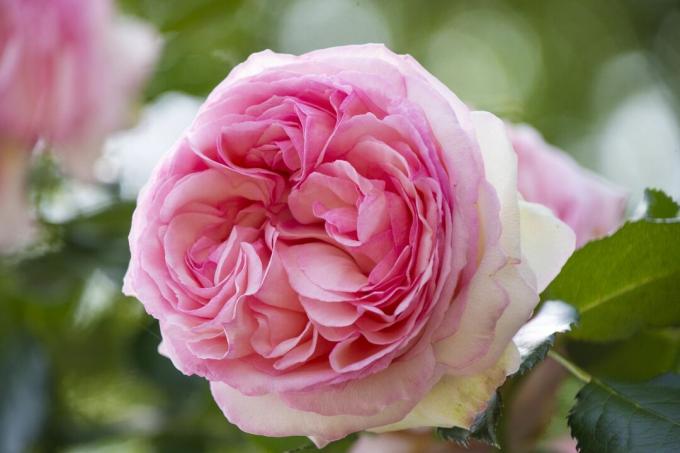
A review article on the Planting, caring for and cutting climbing roses have prepared here for you.
More beautiful and sturdy Climbing rose varieties can also be found in our special article.
Dwarf roses
Miniature roses are characterized by their compact growth and are therefore also referred to as miniature roses. Mini roses are only about 30 to 50 cm high and are therefore also suitable for smaller gardens. Due to the small footprint, they can also be planted in a pot to decorate the terrace or balcony. A large selection of different types of dwarf rose is available in stores.
Perhaps this small selection can serve as inspiration for you:
-
‘Clementine’
Double apricot-orange flowers; more often blooming; good shelf life of the flowers; upright, bushy growth; suitable for planting in pots; Winter protection required -
'Mandarin'
Double, orange-pink flowers with a yellow center; more often blooming; dense, compact growth; medium leaf health; hardy -
'Mandy'
Half-double flowers in blood red; more often blooming; weak fragrance; bushy growth; good leaf health; conditionally hardy - winter protection recommended -
‘Orange Jewel’
Salmon orange, densely double flowers in umbels; more often blooming; dense, compact growth; medium leaf health; long shelf life of the flowers -
‘White Babyflor’
Small, well-filled flowers in white; more often blooming; compact growth; medium leaf health; ideal for planting in pots

Hybrid Tea Roses
Hybrid tea roses were created in the 19th Century from the crossing of Chinese tea roses and European remontant roses. That is why they are often referred to as tea hybrids. Hybrid tea roses are among the oldest modern roses and brought many positive properties - such as an expanded color range, new fragrances and a longer bloom - to rose cultivation. Negative properties of Chinese roses - such as the increased susceptibility to rose diseases and the Insufficient winter hardiness - due to successful breeding work these days, hybrid tea roses are hardly of any concern Meaning.
In addition to the well-known red hybrid tea roses, there are also many other color variants.
In the following we would like to introduce you to some particularly beautiful varieties:
-
‘Augusta Luise’
Large, peach colored flowers; fruity sweet fragrance; strong, upright growth; reaches heights of up to 120 cm; good leaf health; hardy -
‘Gloria Dei’
Also as ‘Madame A. Meilland ’or‘ Peace ’known; loose, light yellow flowers with a pink margin; pleasant smell; bushy growth; grows up to 100 cm high; weatherproof -
‘Countess Diana’
Named after Countess Diana Bernadotte; purple-violet flowers; intense fragrance; upright, bushy growth; reaches heights of up to 120 cm; ADR rose; conditionally hardy -
‘Pascali’
Medium-sized, pure white flowers in a noble shape; delicate fragrance; abundant flowering; strong, bushy growth; grows up to 70 cm high; good leaf health -
‘Sutters Gold’
Loose flowers in light orange with a reddish sheen in the edge; strong fragrance; reaches heights of growth of up to 100 cm; medium leaf health
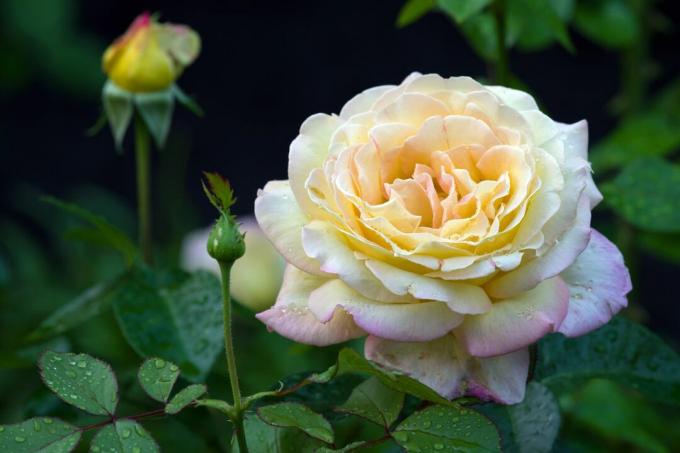
More gorgeous Hybrid tea varieties can be found here.
Wild roses
All modern cultivated roses come from the robust wild roses. For ecological reasons it can make sense to fall back on these original species, because the simple flowers serve as a food source for bees and other insects. The fruits (rosehips), which form in late autumn, are in turn eaten by birds. But also from a technical point of view, there are a few arguments in favor of planting a wild rose. Compared to modern varieties, the wild forms are usually easier to care for and less prone to plant diseases.
Perhaps there is already a suitable species for your garden here:
-
Vinegar rose - Rosa gallica
Semi-double, rose-red flowers; strong fragrance; upright, bushy growth with overhanging shoots (up to 120 cm high); shade compatible; high leaf health -
Pike rose - Rosa glauca
Cup-shaped, light pink flowers; heavy fruiting from August; Leaves shimmering bluish in summer; bushy, upright growth; becomes 150 to 250 cm high; pretty tough -
Chinese gold rose - Rosa hugonis
Small flowers of light golden yellow; blooms from May; black red rose hips; broad, bushy, overhanging growth (up to 200 cm high); conditionally hardy -
Tufted rose - Pink multiflora
Numerous small flowers in white; strong scent of honey; forms rounded rose hips; upright growth with arching overhanging shoots; grows up to 300 cm high; hardy -
Wine rose - Rosa rubiginosa
Single flowers of light carmine pink; Leaves smell of apple or wine; upright growth with overhanging shoots (up to 350 cm high); heavily bribed
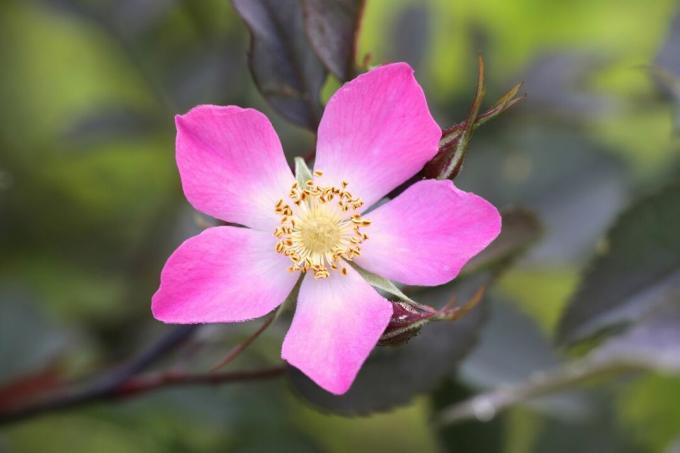
More gorgeous Wild rose species as well as tips for cutting wild roses can be found here.
Historic roses
Historical or old roses are the garden roses that have been cultivated the longest. These include those roses that were already in cultivation before the introduction of the first hybrid tea in 1867, even if individual varieties only emerged later (for example by crossing two varieties of the old roses) are. Depending on the parentage, for example, the Gallica-Roses, Alba-Roses, Damascene- A distinction can be made between roses and centifolia. These main groups mainly include single-flowering varieties, because more frequent-flowering varieties only emerged in the course of the 19th century. Century. The dense, fragrant flowers, the stately growth and the pastel color of the petals are also characteristic of old roses.
The historical roses include the following varieties:
-
‘Charles de Mills’
Gallica-Rose from 1746; double, purple-violet flowers; single flowering; strong fragrance; broad bushy growth; rain and heat resistant; hardy -
"Gallica Officinalis"
Probably the oldest European variety (since 1310); semi-double, pink-red flowers with a strong fragrance; single flowering; shade compatible; very good leaf health -
‘Mme Hardy’
French breed from 1832; tightly double, pure white flowers with a green eye; single flowering; gives off a strong lemon scent; very healthy; hardy -
‘Mme Isaac Pereire’
French breed from 1881; double, carmine-pink flowers; more often blooming; strong fragrance; vigorous; medium leaf health; hardy -
‘Louise Odier’
Variety from 1851; tightly double, pure pink flowers; intense fragrance; more often blooming; shrub-like growth with overhanging shoots; Winter protection recommended
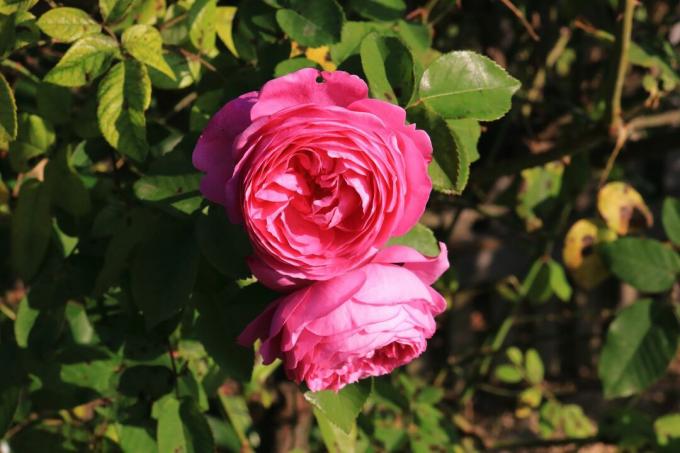
Ground cover roses
Ground cover roses are nothing more than low-growing bed or shrub roses, which is why they are often referred to as small shrub roses in the trade. The undemanding permanent bloomers reach heights of about 20 to 100 centimeters and usually inspire with their blossoms until autumn. As a rule, ground cover roses are very robust, flowering and long-lived. They come into their own when you place them in groups of three to five plants per square meter, depending on the vigor of the variety. In combination with tree roses or matching perennials and grasses, wonderful beds can be created.
The following varieties of ground cover roses are particularly popular:
-
‘Apple blossom’
Simple, white flowers in umbels; delicate fragrance; soft, pliable shoots; reaches heights of up to 80 cm; high leaf health -
‘Gardener's joy’
Also known as ‘Toscana’; small, double flowers in raspberry red; flat growth; reaches heights of growth between 40 and 50 cm; very easy to care for; good leaf health; hardy -
'Heath dream'
Numerous carmine-pink flowers; slightly fragrant; bushy growth (up to 80 cm high); hardly any maintenance necessary; Flowers are rainproof and tolerant of heat; good leaf health -
‘Mainaufeuer’
Blood-red, loosely double flowers; broad, upright growth; reaches heights of up to 60 cm; robust variety with good long-range effect; hardy -
‘The Fairy’
Small, double flowers in salmon pink; broad bushy growth (up to 80 cm high); heat tolerant; good leaf health; suitable for embankments and slopes
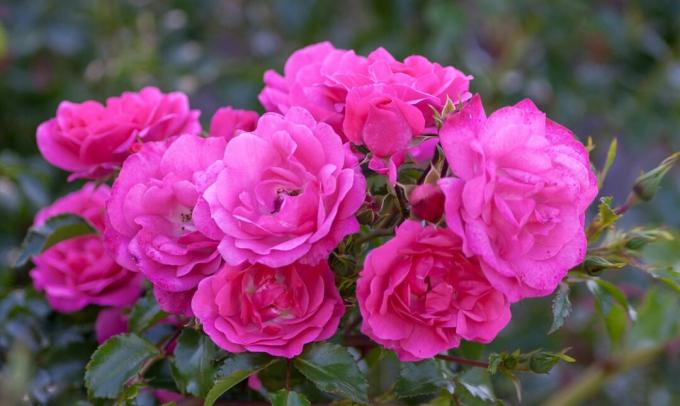
W.fester beautiful Ground cover rose varieties can be found here.
Tree roses
Strictly speaking, stem roses are always composed of two varieties. Most roses naturally do not form stems, which is why flowering bed or hybrid tea roses are grafted on specially grown wild rose shoots. Depending on the stem height, one and the same variety is offered as a dwarf stem rose (up to 50 centimeters), half stem rose (up to 70 centimeters) and / or as a standard rose (about 90 centimeters), depending on the provider. So-called cascade stem roses are varieties of climbing or rambler roses that have been grafted on wild roses. These usually form long, overhanging shoots and reach heights of around 120 to 140 centimeters.
Here is a small selection of beautiful stem roses in different colors, shapes and sizes:
-
‘Leonardo da Vinci’
Mini stem rose with double, dark pink flowers; Flower color hardly fades; delicate fragrance; Trunk height of about 50 cm; medium leaf health; hardy -
‘Marie Curie’
Half trunk (about 70 cm high) with a compact, bushy crown; Depending on the weather, the flowers are colored apricot-orange to pink; pleasant smell; good leaf health; hardy -
'Minerva'
Half-stem (about 60 cm high) with double, lilac flowers; wonderful fragrance; blooms from early summer to autumn; hardy; suitable for planting in pots -
‘Goldelse’
Compact high trunk (about 90 cm high) with double, decoratively wavy flowers in dark orange; delicate fragrance; medium leaf health; very good winter hardiness -
‘Golden Celebration’
English cascade stem rose (about 140 cm high); magnificent, double flowers in a rich golden yellow; intense berry scent; broad bushy growth; good leaf health

Scented roses
The scent of roses not only attracts many insects, but also makes rose lovers rave in the truest sense of the word. However, the selection of scented roses is not too large compared to the totality of rose varieties, because unfortunately in In the last few decades in rose breeding mainly on the appearance, that is, on the shape and color of the flowers, respected. Many modern rose varieties have a very little or no scent at all. Nowadays, specially grown fragrant roses often come from strongly scented wild roses. You can find them mainly among the old roses, the English roses, but also among the hybrid tea roses.
Here is a small selection of popular scented roses:
-
English rose ‘Constance Spry’
Popular shrub rose; double, pink flowers with a light edge; intense scent of myrrh; single flowering; upright bushy growth; poor leaf health; hardy -
Hybrid tea ‘fragrance cloud’
Double, coral red flowers; more often blooming; intense hybrid tea scent; bushy growth; good leaf health; Awarded a World Rose and ADR Rose among others -
Hybrid tea ‘Frederic Mistral’
Large, double flowers in light pink; more often blooming; intense fragrance with a hint of lime; strong, upright, bushy growth; medium leaf health; good winter hardiness -
Rambler rose ‘Guirlande d‘Amour’
Many half-double, pure white flowers in racemes; more often blooming; sweet smell; reaches heights of up to 4 m; very good leaf health; hardy; suitable for rose arches -
Shrub rose ‘Rose de Resht’
Medium-sized, bright red flowers; more often blooming; heavy rose scent; compact growth habit; good leaf health; rain and heat resistant; hardy

A comprehensive collection at Scented rose varieties with special flavors we have prepared for you here.
English roses
The English rose class was coined by the Englishman David Austin. In 1961, he was the first rose breeder to combine the characteristics of beautiful, fragrant old roses with those of the to combine modern tea hybrids, which are known for their ability to be reassembled and for their wide range of colors, in one variety. To date, many more varieties of David Austin's roses have been added.
We would like to introduce you to a small selection of particularly beautiful varieties below:
-
‘Abraham Darby’
Double flowers in apricot to yellow-orange; fruity fragrance with a bitter base note; shrubby growth with overhanging shoots (up to 200 cm high); easy-care; hardy -
‘Graham Thomas’
Double flowers in strong yellow; intense scent of tea roses; upright, bushy growth; reaches heights of up to 200 cm; medium leaf health; heat tolerant; hardy -
‘Heritage’
Double, light pink flowers; intense fragrance; well branched, upright, bushy growth; reaches heights of up to 150 cm; medium leaf health; rainproof flowers; hardy -
"Mary Rose"
Double flowers in pink; Scent of old roses, almonds and honey; shrubby growth; reaches heights of up to 150 cm; heat and rainproof; easy-care -
‘The Pilgrim’
Dense, central yellow flowers with a white border; light fragrance; compact, bushy growth; with trellis up to 350 cm high; medium leaf health; hardy
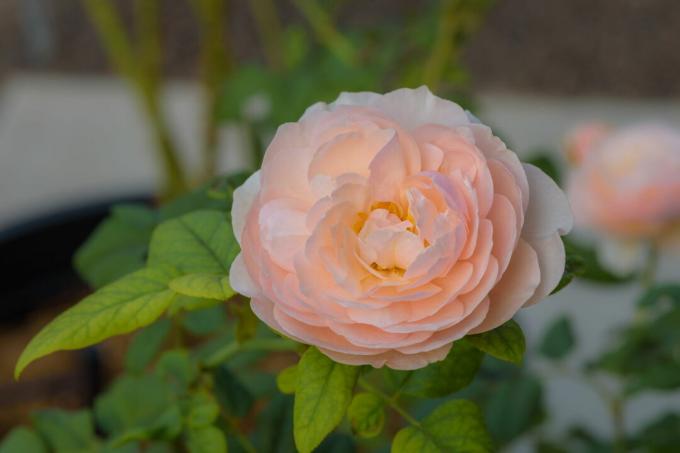
In our special article we introduce you to other types of English roses and tell you where you can buy particularly beautiful specimens.
ADR roses
The world of roses is growing by many varieties every year. In order to sharpen the awareness of the variety and to be able to assess new breeds according to their use, the General German Rose Novelty Examination, or ADR for short, was founded in 1950. The working group behind it consists of representatives of the Association of German Tree Nurseries, rose breeders and independent experts. Since then, the “ADR Rose” award has been given to those new rose varieties that remain healthy when planted in eleven viewing gardens and also have a high ornamental value. Over a period of three years, for example, the effect of the flower, the scent, the winter hardiness and, last but not least, the resistance to leaf diseases are tested annually. In contrast to other rose awards, the ADR rating can also be withdrawn due to the more stringent examination conditions.
Red roses are the absolute classics. We will provide you with the most beautiful red rose varieties and their properties.
